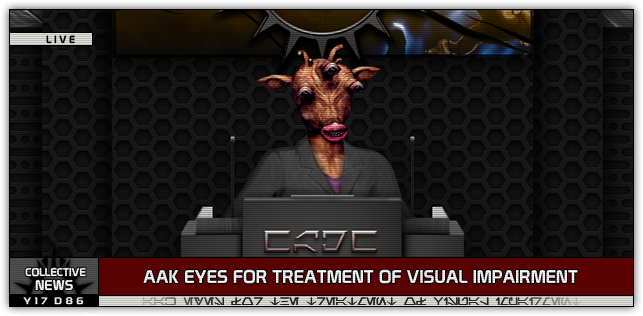Where Once There Was Darkness
Where Once There Was Darkness
Posted by: Rennek Cor - Faction: Black Sun
Date: Year 17 Day 87 Onboard the R&D IV [BSS] Angelic Observatory Platform in system Iego (412, 227).
A Black Sun government spokesperson today announced that the outcomes of research have yielded “incredibly promising results” in the field of treatment for non-congenital blindness.
Paks Rees addressed the assembled press to bring the news that the report, which was commissioned by the Black Sun prior to their reinstatement to government status, shows marked recovery of vision across multiple species up to a 93% improvement rating. The report is due for general public release imminently.
“The Black Sun values its citizens livelihoods and well-being, one of the many reasons we have been able to thrive and ensure success across our planetary populations.” Rees stated, taking only a brief moment to consult her notes atop the podium the Gran stood behind. “As part of this investment in the people, the Family Council commissioned Cor Research & Development Concepts (CRDC), an independent think tank, to work on developing a mass producible cure for visual impairment in sentient species, using readily available galactic resources.”
Ganice Singh M.D, the project lead at CRDC, took a moment to speak to the journalists present. “Black Sun came to the team with a clear message, a cure for blindness without cybernetics, using readily available and affordable materials. Having practiced medicine for over 30 years with a specialty in Optometry, I had become familiar with research by my peers in the use of limbal stem cells to regenerate damage in the eyes and this became the basis for our study.”
The excitement was barely masked by the Pau’an’s strong features as he continued. “What became clear very quickly was, with the vast amount of hunting being undertaken following relaxation of venatic laws galaxy wide, the market and indeed the ground environments were quickly being flooded by ‘trophies’. We felt that if we could find species with an ability to preserve the optic area of the body postmortem, we could explore the use of the stem cells present in these for the treatment.”
Of the species that showed this trait, it was also a requirement that: the eye have a cornea, to ensure the presence of slow-cycling basal cells; the creatures' Galactic Standard Rarity rating be low, for environmental sustainability purposes; and the eye be large enough to hold as many stem cells as possible, to ensure maximum yield. The only species to show these traits was the Aak Dog, and it was the Aak eye that went on to laboratory trials.
18 Months of research and testing has culminated in the first set of sentient trials, which have to date shown the same trajectory of recovery seen during the lab phase. It is estimated that up to 75% of vision on average can be recovered following 6 months of treatment, at which time the results plateau. What this means is a non-invasive cure for blindness, caused by such things as burns, radiation, genetic disorders and extensive ryll use, without aesthetic or invasive surgical disruption to one's life.
Rees closed the press conference with news that “Black Sun has since commissioned two further projects with CRDC, the first to try to synthetically produce the stem cells and negate the requirement for the Aak eyes, the second to establish whether any other trophies can be utilized for the betterment of the medical world and general populace. We will of course be looking to make these papers publicly available upon their completion.”
The papers have since been released and can be accessed using this link: Project Lawton

